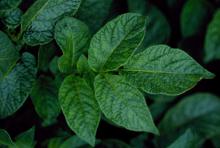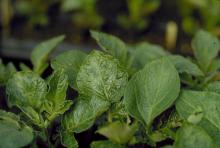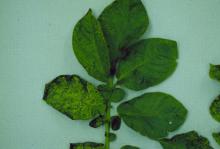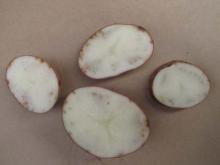By K. Frost and C. M. Ocamb
See:
Potato (Solanum tuberosum) - Potato Virus Y
Cause Several viruses including potato virus X (PVX), potato virus S (PVS), potato virus A (PVA), and sometimes potato virus Y (PVY). These viruses are transmitted mechanically and by insects, primarily aphids. Research shows that PVX in combination with PVS reduces yields 10% to 25%, and PVY can reduce yields, particularly in the high-yielding, long-growing season of the Columbia Basin, when growing most varieties. Besides yield reduction, the occurrence of PVY "strains" can also result in tuber quality issues. Secondary spread from plants growing from infected seed can occur. The amount of virus allowed in certified potatoes differs between states.
Symptoms PVX, PVS, and PVA normally do not cause obvious symptoms in most popular potato varieties, hence the designation "latent." However, PVY usually causes a leaf mosaic but can cause latent infection in some potato varieties. Infection by these viruses may cause a mild mottle, slight distortion of leaves, or an easily recognized "mosaic" symptom. Infection in the varieties, Shepody and Russet Norkotah, cause symptoms that are extremely difficult to see, whereas a leaf mosaic can be easily observed on 'Russet Burbank'.
Cultural control Use seed from a certification program that tests for latent viruses. Use both field data and winter grow-out information to select seed lots. Then take the following steps to prevent introducing and spreading viruses within the crop.
- Disinfect cutting and planting equipment before use. See materials under Potato (Solanum tuberosum) - Ring Rot.
- Avoid cutting sprouted seed tubers.
- Minimize cultivation to prevent spreading the disease mechanically. Cultivate when vines are dry. Disinfect cultivation equipment when moving from a latent virus-infected field to one that is not. Better yet, use one set of equipment only in the virus-free fields.
- Solid-set irrigation will decrease mechanical spread.
- If a seed grower, rogue all infected plants, including daughter tubers. Do it early in the season before vines touch. Later, rogue when the vines are dry. Immediately place rogued vines and tubers in a clean sack to prevent spread as you move down the rows.
Chemical control Control aphids. Preventing spread into a field is unlikely but controlling the spread of these viruses in a field is possible with insecticide use. See the PNW Insect Management Handbook for details.





